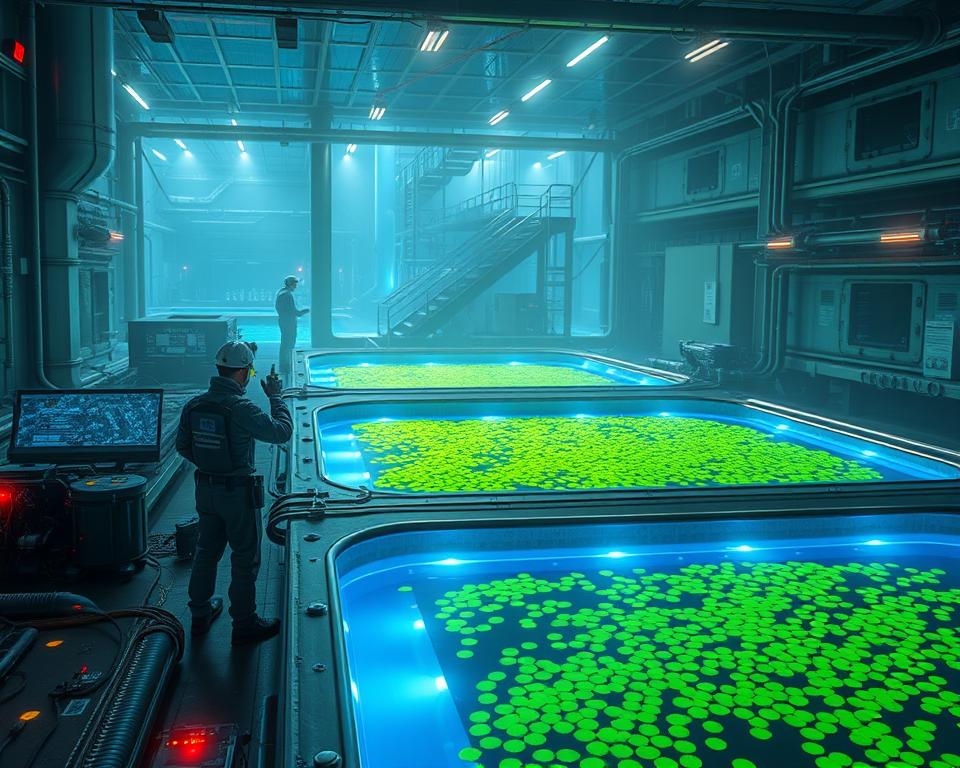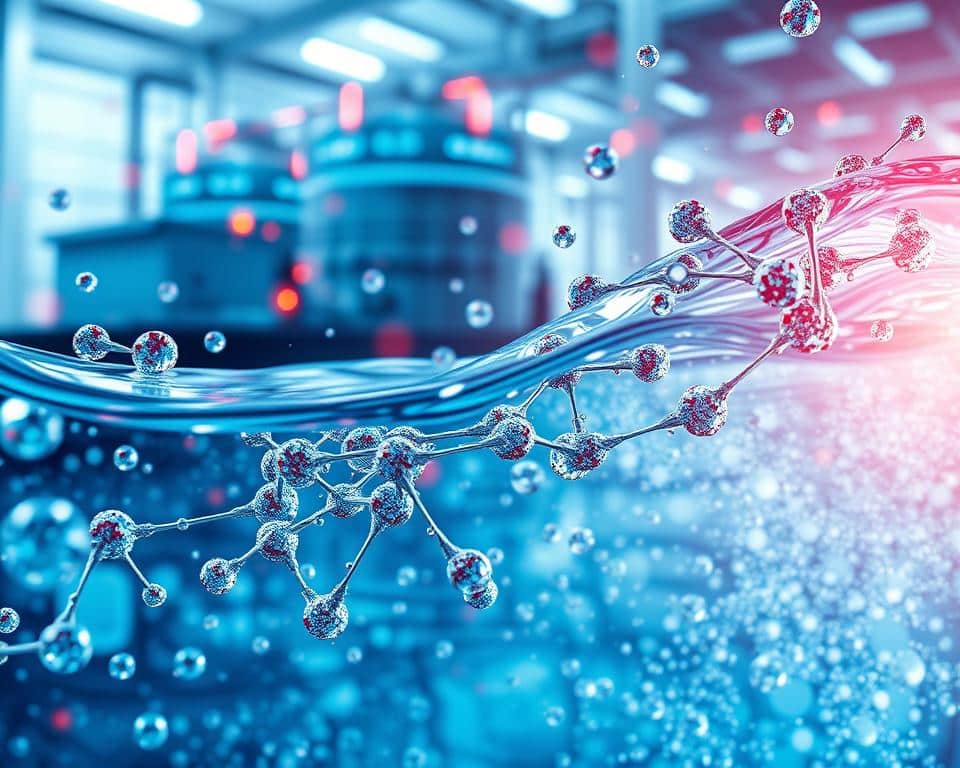Over half the world worries about running out of water. This makes the study of nanotechnology and water treatment very important. Our larger population needs more clean water. Nanostructured membranes stand out by filtering tiny particles and removing almost all contaminants.
Nanotechnology plays a big part in cleaning our water. Nanofiltration membranes last up to 5 years and can save up to 90% of water. They make filtering water more efficient and use less energy, about 30% less. This technology is key in fighting water pollution. It ensures the smallest pollutants are caught, keeping our water clean.
Introduction to Nanotechnology in Water Purification
Nanotechnology works at an incredibly small scale to revolutionize water purification. It manipulates materials smaller than 100 nanometers for better results. With the global need for clean water soaring, nanotechnology’s role in water purification is more crucial than ever.
What is Nanotechnology?
Nanotechnology involves controlling matter at the molecular or atomic level. This gives materials new properties. For example, water filtered with a nanoporous membrane is often purer than water treated by conventional methods.
The Growing Need for Clean Water
More than 1.1 billion people don’t have access to clean water. Additionally, 2.7 billion face water scarcity for a month annually. By 2025, two-thirds of the world could encounter droughts. This makes the innovation in water treatment, including nanotechnology, incredibly important.
Poor sanitation impacts 2.4 billion people, raising the risk for illness. Diseases like typhoid and diarrhea cause around 2 million deaths a year, mostly among children. There’s a strong need for new solutions to these problems, with water pollution being a primary concern.
Water Pollution and Its Effects
Water pollution from various contaminants poses serious health risks. Traditional treatments often can’t remove all pollutants. Nanotechnology brings powerful solutions for these challenges.
For instance, nanomaterials like carbon nanotubes effectively filter heavy metals and organic contaminants. The nanotechnology market in water treatment, worth USD 1.90 billion in 2023, is predicted to grow. By 2030, it could reach USD 3.50 billion.
There’s a pressing need for solutions to water scarcity and pollution. Nanotechnology offers promising technologies for these challenges. For a deeper understanding of how nanotechnology can change water purification, check out this detailed guide.
Benefits of Nanotechnology in Water Purification
Nanotechnology plays a key role in improving water purification. It offers many benefits, leading to sustainable water treatment. These include better filtration, energy savings, and adaptability to different scales.
Enhanced Filtration Efficiency
Nanomaterials like titanium dioxide and iron-based particles are great for purifying water. Titanium dioxide uses sunlight to break down pollutants. Iron-based particles are good at capturing heavy metals.
Another material, graphene, excels in removing pollutants and heavy metals due to its large surface. This results in highly effective filtration methods.

Energy Savings
Using nanotechnology in water purification saves energy. Silver nanoparticles and carbon nanotubes disinfect water with less energy. This is more efficient than older methods.
Titanium dioxide nanoparticles need only UV light to kill microbes. This process doesn’t require extra energy, making the treatment more sustainable.
Sustainability and Scalability
Nanomaterials are both sustainable and scalable for purifying water. They last a long time, which means less need for replacements. For instance, silver nanoparticles are effective for extended periods in disinfecting water.
The adaptability of nanotechnology covers small to large scale uses. It meets the needs of different areas efficiently. Thus, these technologies are suitable for various water treatment sizes.
Types of Nanomaterials Used in Water Purification
Nanomaterials are changing how we clean water, by targeting specific pollutants. Types like carbon nanotubes and graphene oxide target chemicals and odors. Silver nanoparticles deal with bacteria, and iron oxide nanoparticles remove heavy metals.
Carbon Nanotubes and Graphene Oxide
Carbon nanotubes and graphene oxides are celebrated for their strength and ability to conduct. Their tiny pores catch and remove small pollutants. Graphene oxide in water treatment can cut down chemicals and bad smells effectively.
Silver Nanoparticles
Silver nanoparticles use silver’s antibacterial traits to clean water. They stop microbes from growing, preventing biofouling. This makes water safer to drink.
Iron Oxide Nanoparticles
Iron oxide nanoparticles are great for catching heavy metals like arsenic. They bind to metals and use magnetic separation for easier removal. This method has transformed both industrial and home water cleaning.
| Nanomaterial | Application | Benefits |
|---|---|---|
| Carbon Nanotubes | Adsorption of contaminants | Effective removal of small contaminants |
| Graphene Oxide | Water treatment | Reduces chemicals, odors, and tastes |
| Silver Nanoparticles | Disinfection | Inhibits microbial growth |
| Iron Oxide Nanoparticles | Pollutant removal | Efficient heavy metal removal |
Applications of Nanotechnology in Industrial Water Treatment
Industries use 22% of the world’s water, so treating this water well is key. Nanotechnology is changing how we treat water in areas like textiles, pharmaceuticals, and mining. It helps tackle different pollutants, from harmful dyes to heavy metals, ensuring water is clean for making products.

In water treatment for industries, nanotechnology shines. For example, in mining, it’s used to clean away dangerous metals like lead and mercury. Nanocomposites, because they have a big surface area and are chemically active, are great for this job. Plus, nanofiltration systems can handle lots of water, making them perfect for big projects.
Nanofiltration is also key in food and drink making, keeping water safe to meet strict health rules. With 80% of waste water ending up in rivers and oceans, nanotechnology could really help the planet. Studies have found that certain nano-photocatalysts are really good at breaking down pollutants, offering a new way to clean water.
- Textiles: Removing dyes and ensuring safe discharge.
- Pharmaceuticals: Contaminant-free water for drug manufacturing.
- Power Generation: Specialized filtration methods to handle cooling water and other chemicals.
- Food & Beverage Production: Hygienic water for food safety and processing.
- Mining: Effective removal of heavy metals and metalloids.
Recent studies show that biochar nanocomposites and WO3 nanoparticles are really promising for cleaning water. For instance, WO3 nanoparticles got rid of 94.8% of a dye called methylene blue. Also, silica materials doped with Al and Sn have shown to be super effective, with one, in particular, being able to absorb a huge amount of pollutants.
Here’s a table that shows how well nanotechnology works in different industrial water treatment areas:
| Industry | Contaminants | Nanomaterials | Efficiency |
|---|---|---|---|
| Textiles | Dyes, Heavy Metals | Biochar-Based Nanocomposites | High |
| Pharmaceuticals | Trace Chemicals | Scalable Nanofiltration | Very High |
| Power Generation | Cooling Water Contaminants | ZrO2 Nano-Photocatalysts | Outstanding |
| Food & Beverage | Organic Pollutants | WO3 Nanoparticles | 94.8% |
| Mining | Heavy Metals (Pb, Cd, Hg) | Sn50-TUD-1 Adsorbent | 1785.6 mg/g |
Nanotechnology brings big benefits like saving energy and better water quality. Scalable nanofiltration and other nano methods are key for treating water in industries.
Challenges and Concerns with Nanotechnology in Water
Nanotechnology could change how we purify water, but it’s not without issues. The excitement for nanomaterials often overlooks their risks. We must ensure their use is safe and sustainable.
Environmental and Health Risks
Nanomaterials are very reactive and tiny, from 1 to 100 nanometers. This can cause unexpected issues in nature. Studies show they could harm water purity after treatment. They might also hurt soil life, build up in the environment, and kill helpful bacteria.
Research warns that they could affect wildlife and ecosystems, especially plants and sea life. We need long-term studies to really understand their effects on nature and our health. Wastewater with nanoparticles has a big impact on the environment. This calls for thorough solutions.
For more details, check the water treatment monitoring article.
Regulatory Standards and Monitoring
We need strong rules to handle these risks. The EPA and EFSA give guidelines for nanomaterials’ safe use. Rules should keep up with new information to be strict about using, watching, and throwing away nanomaterials.
It’s crucial to monitor water treatment to confirm nanotechnology is safe. Detailed checks can assure everyone that nanomaterials are used correctly. We must carefully dispose of them to avoid other pollution, keeping our environment and water clean.
Conclusion
Nanotechnology improves water purification by using the power of tiny materials. It provides some of the best water treatment solutions we have today. This method improves how we filter water and remove harmful substances.
Research in journals like Water Res and Chemosphere shows how nanotechnology tackles water pollution. It looks into the impact of tiny materials in water and how we can better clean wastewater. This research points out the great potential and the challenges of using nanotechnology for cleaner water.
Looking forward, it’s important to use nanomaterials wisely, considering their impact on the environment and health. Studies in journals like Environ Pollut highlight the need for strong rules and constant checks. By focusing on innovation and sustainability, we can aim for a future where everyone has access to clean, safe water. This helps both nature and people stay healthy.

